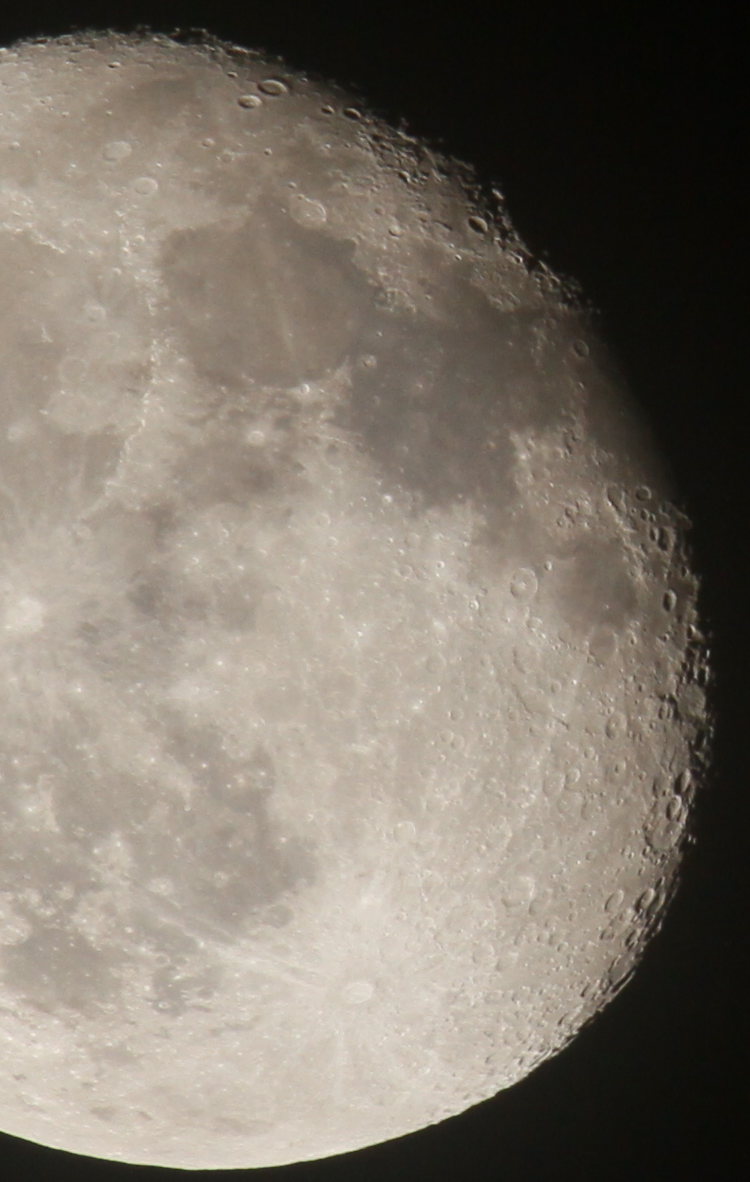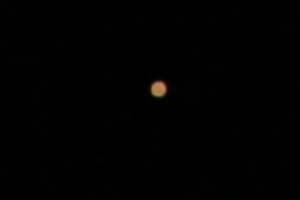
While the sky was cloudy earlier in the evening of the 4th, it (mostly) cleared to allow a couple of moon shot experiments, and I thought I’d throw one up here… with the possibility of a follow-up later on. It’s quarter to three AM right now on the morning of the 5th, the moon riding very high, but it will set about 10:30 AM and rise again about 9 PM, allowing another chance before the day is out to see the progression of the phase, in this case waning from full a couple of days ago. So if the sky is clear, I might be back.
Now, a couple of notes. You may recall from a previous post the mention of the brightest spot on the near side of the moon, which is Aristarchus; it was visible then in the earthshine, and here as the bright spot straight to the left. In the crescent photos of that post, the crater Grimaldi sat right on the terminator, but here it is clearly visible as the dark spot in the brighter region that sits lower left. You might even notice that you can just barely see a couple of bumps on the outline of the moon, again, the most distinctive perhaps being just beyond Grimaldi at lower left. To the best that I can determine, these are the peaks of the Montes Cordillera range that forms the rim of Mare Orientale, out of sight around the edge of the moon.
The above image showing the whole moon (what we can see of it) is a little less than full resolution, so for giggles, I did a cropped, full-res version of the terminator, to show the best detail that I’ve captured with the Tamron 150-600 lens.

All those details to the right, along the terminator, have the highest contrast and thus are what I use to adjust sharp focus upon; autofocus isn’t trustworthy for this, and in fact, manual focus leaves a lot to be desired, so I usually shoot several frames, readjusting focus for each, because that perfect spot is impossible to determine in the viewfinder. And while it’s also impossible to demonstrate the view accurately here, given the huge variation in monitor sizes that anyone might be using to see this post, I’ll make the attempt anyway.

This is the entire frame of the same images above, and this is roughly as big as it looks in the viewfinder of the camera. So those details to the right are the ones I’m attempting to get the sharpest to know that I have the best focus. Yeah, sometimes they’re good, for the image used in this post, and sometimes not so good – I have multiple attempts from this morning, all within a few minutes, and plenty of near-misses.
 While I was out there, I re-aimed the tripod just a little and captured another subject: Mars. A few days ago it was riding close to the full moon, but I was too tired to do a session then. Here, I was lucky to get just the barest hint of color variation from the disc, but this is full resolution and as good as it’s gonna get without a telescope. Eventually, I’ll get that together, and maybe then we’ll see something more.
While I was out there, I re-aimed the tripod just a little and captured another subject: Mars. A few days ago it was riding close to the full moon, but I was too tired to do a session then. Here, I was lucky to get just the barest hint of color variation from the disc, but this is full resolution and as good as it’s gonna get without a telescope. Eventually, I’ll get that together, and maybe then we’ll see something more.




















































